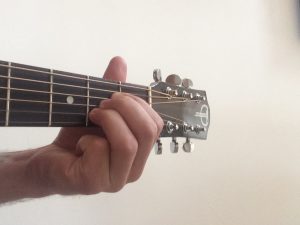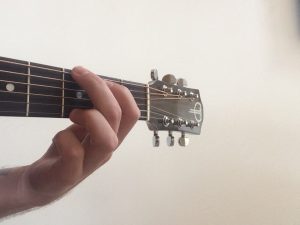Welcome to Part One of Your First Song, a four-part series made especially for beginner guitarists.
If you want to learn to play a song but you’re feeling a little intimidated, have no fear: learning a song can actually be very easy. Just follow the simple instructions from each of the four parts in this series – on chords, strumming, transitions, and singing – and you’ll be playing in no time. To start, let’s learn a few easy guitar chords.
Three-Chord Songs
In the guitar world, ‘three-chord songs’ is a phrase that’s passed around a lot. That’s because there’s a lot of them. From Bob Dylan’s ‘Like a Rolling Stone’ to AC/DC’s ‘You Shook Me All Night Long’ to practically every blues song ever written, there are almost too many three-chord songs to count! (For an awesome video showing thirty more of these three-chord songs on guitar, click here).
‘There are almost too many three-chord songs to count!’
Lucky for us, this makes learning a song just that much easier. For this series, we’re going to choose The Beatles’ version of ‘Twist and Shout’, one of the true rock anthems of our time. It’s a great tune, it’s fun to play, and most importantly it’s incredibly easy to learn.

Three Easy Guitar Chords
‘Twist and Shout’ uses the chords G, A, and D – all great guitar chords for beginners. There are different ways of playing these chords. For this series we’re going to learn them in the standard chord position, which is the most common way to play them.
Tabs and Chord Diagrams
Most music uses staff notation, but for guitars we generally use chord diagrams, which are mini diagrams of the fretboard that show finger placement, and tabs.
(For a quick guide on the different parts of a guitar, click here).
Both tabs and chord diagrams are easy to learn. For now, we’ll start with chord diagrams for each of our three chords: G, A, and D.
Here is the chord diagram for a standard G major chord:
Reading the chord diagram above is quite easy – after all, it’s just a visual representation of the fretboard. To understand one, set your guitar against a wall with the strings facing you, as in the picture below.
Here’s the way it works:
- 6 vertical lines on the tab grid = 6 guitar strings.
(Biggest string on the left, smallest string on the right.)
- Each horizontal line on the tab is a fret.
(First fret on top and descending downward.)
- Each circle marks where to put a finger.
(One finger per dot, pressing down on the fretboard.)
- The numbers below stand for which finger to use.
(1 = index finger, 2 = middle finger, etc.)
(0 = play the open string without pressing a fret.)
(x = don’t play this string.)
Now see if you can put your fingers down in the right places to make a G chord. The picture below shows what it should look like. Give it a good strum.
Congratulations, you just played your first guitar chord!
Now see if you can do it with the other two chords, A major and D major.
Be patient with yourself. It’s tricky at first to get your fingers to stay in position and keep holding down each string. It can be a little painful, too – that’s just because your fingers aren’t used to it. In time this pain will lessen as you play more.
‘It can be a little painful [at first] … this … will lessen as you play more.’
(Is learning three chords too frustrating? Learn to play a three-chord song with just one chord position by clicking here. Alternatively, try these easy electric guitar songs – they can take even less time to learn!)
A Few Helpful Tips
- When you put a finger down on the fretboard, be sure to place it just to the left of the fret so that the fret and the string can make good contact with each other (though this may be tricky with the A major chord). This contact is what produces a clear-sounding note.
- When making these chords, your fingers may accidentally press down on strings they don’t mean to, leading to unwanted notes or muted strings. That’s OK. Down the road you’ll want to avoid this, but for now don’t fret over it (haha get it?).
- Be patient with yourself. Time and persistence are your best allies. Go slow, keep practicing each chord, and remember that with each successive strum you’re getting better! (For now, don’t worry about chord transitions – we’ll cover that in Part Three of this series).
And there you have it – a few easy guitar chords for you beginners. Keep practicing those chords and you’ll be playing ‘Twist and Shout’ in no time!
Having trouble with strumming or getting the notes to ring out clearly? Help’s on the way! Read Part Two: How to Strum a Guitar for more tips on playing easy guitar chords and links to other articles in this series.

Cody is a professional singer, songwriter, performer, and recording artist. His instruments include bass, trumpet, drums, harmonica, piano, and most especially guitar. In his spare time he travels, brands businesses, and makes lists of his many accomplishments.
Cody is a student at the University of Utah under his own self-created degree, Music Business and Technology, and recently returned from four months living in Kathmandu, Nepal providing humanitarian aid to the victims of the recent earthquake.
Watch the music video for ‘Batti Ayo’, Cody’s tribute to the Nepal quake victims, at codyrobinsonmusic.com
Or follow him on Instagram: @codyculture










